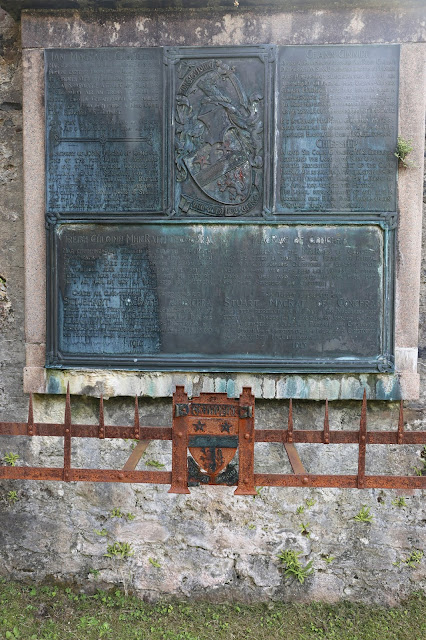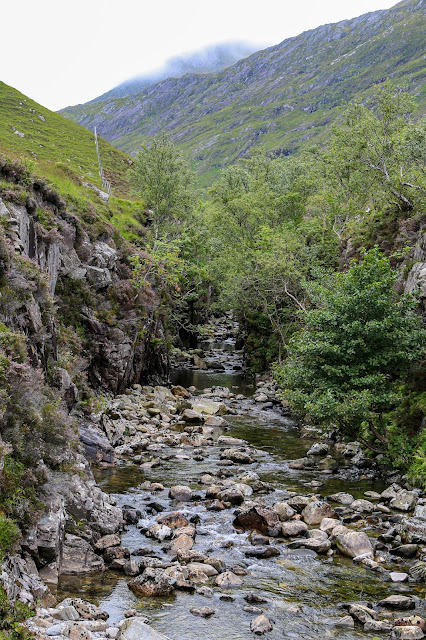Travelling on the A82 north via Glencoe and Fort William picking up the A87 and onto Morvich Caravan and Motorhome Club you witness some of the reasons why Scotland boasts some of the most picturesque country side anywhere.
The campsite is situated in a lush green wooded valley surrounded by natural beauty with one of the finest stretches of mountain scenery in northwest Scotland. Designated as a National Scenic Area and mostly owned by the National Trust since 1944 the site is very popular with walkers and hikers - lots of wee one person tents on site.
Approximately 1.5 miles from the site is a wee general store Kintail Crafts that sells almost anything including, most importantly, supplies should you run out of anything. Not much further is a coffee shop outside the Kintail Lodge Hotel, well worth sampling the bacon rolls and hot chocolate.
Turn right out of the camp site and right again at the end of the road, over the bridge and follow the road towards the main road you will come across the roofless shell of St. Dubbtbach’s, the old Parish Church of Kintail dating from the 15th century. Interestingly it was shelled by government ships in pursuit of a Spanish backed Jacobite expedition which landed here in 1719, but was later repaired. The church fell from use in the middle of the 19th century.
Next to church is the Clachan Dutch, the traditional burial ground of Clan Macrae. Overlooking both the church and the kirk yard is the Clan MacRae War Memorial erected in 1927.
A plaque inside the church includes the following:
In memory of John MacRa of Conchra one of the four Johns of Scotland and one of the principle officers of William 5th Earl of Seaforth who with most of his Clan fell at the battle of Sheriffmiuir 13th Nov. 1715, defending the cause of the Royal House of Stuart.
“And there fell in the combat the young hero John of Conchra and great was that loss”
As i have already said this part of Scotland is very scenic, but it not just the mountains and hills its the loch’s. The best way to see appreciate Loch Duich is to cycle along the quite roadway up passed Ratagan and on to the old ferryman’s house at Totaig where Loch Duich connects with two other sea lochs, Loch Long and Loch Alsh. Another Jacobite connection, in 1719 the evil British forces burned many homesteads along the lochs shores the preceding the Battle of Glen Shiel on the 10th June 1719.
The Ferrymans House was a grand spot to eat our packed lunch and to see the seals basking on the rocks. From this view point you get a chance to see a rear elevation of Eilean Donan Castle.
Its rare for us to move the motorhome once it is set up on site but it was decided that rather than cycle up the very busy A87 we would take the motorhome to allow us to explore Eilean Donan Castle, one of the reasons for us visiting this part of Scotland. There was plenty of room to park a large vehicle in the castles car park - sensible as this attracts plenty more visitors.
The castle sits on a islet at the mouth of Loch Duich and was the ancestral home of Clan Mackenzie and Clan Macrae and dates from the 13th century. Garrisoned by Spanish Jacobite troops in the abortive rebellion of 1719. The castle was blown up by the English but was later restored between 1919 and 1932 by John MacRae-Gilstrap The restoration included the construction of an arched bridge to give easier access to the island.
Macrae-Gilstrap also established a war memorial dedicated to the men of the MacRae clan who died in the First World War.
My favourite exhibit? the letter from Charles Edward Stuart to Clans to join him in raising his standard at Glennfinnan .
On 19 August 1745, after Prince Charles judged he had enough military support, he climbed the hill near Glenfinnan as MacMaster of Glenaladale raised his royal standard. Charles Edward Stewart announced to all the mustered clans he claimed the British throne in the name of his father James Stuart.
As usual we enjoyed our glimpse of Jacobite history unfortunately we weren't allowed to take photographs inside the castle.
While we had transport we carried on to the Kyle of Lochalsh to shop at their large and friendly Co-Op and have a fish supper overlooking the Skye bridge.
The following day we restricted our walk to a 4 mile circular walk from the caravan site. The route took you along the wee burn that runs along the boundary of the camp site, with views across some open countryside, where a herd of deer were spotted, into a dense forest area, across a footbridge and following the burn back across the lower reaches Beinn Bhuidhe and back to the camp site. Again a walk that takes in the beauty of the surrounding area.
We really enjoyed our stay at Morvich mainly i suppose because we were surrounded by such spectacular scenery. The camp site had a very nice atmosphere and people were friendly most of whom followed the camps covid rules. Would happily come back to this part of the Scottish Highlands.











































Very interesting & luring thanks, If only I was younger & fitter & more healthy!
ReplyDelete